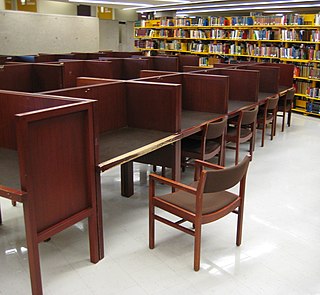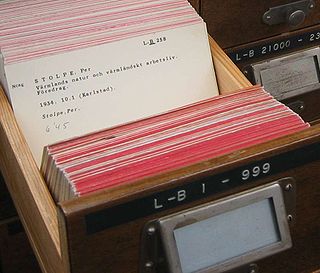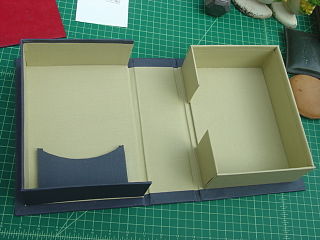 W
WA blind stamp is an image, design or lettering on an art print or book formed by creating a depression in the paper or other material. It is the opposite of embossing which refers to a design created by raising the paper above the surrounding area. It is also distinct from foil stamping, which is a depression that is filled with a thin layer of metal, usually gold.
 W
WA carrel desk is a small desk (usually) featuring high sides meant to visually isolate its user from any surroundings either partially or totally.
 W
WAn index card consists of card stock cut to a standard size, used for recording and storing small amounts of discrete data. A collection of such cards either serves as, or aids the creation of, an index for expedited lookup of information. This system was invented by Carl Linnaeus, around 1760.
 W
WA library card can refer to several cards traditionally used for the management of books and patrons in a library. In its most common use, a library card serves similar functions as a membership card. A person who holds a library card has borrowing or other privileges associated with the issuing library. The library card also serves as a method of identification. When a person chooses an item to borrow and presents their library card to the library, they take responsibility for the borrowed item and promise to abide by certain rules, usually including a promise to return the item by the due date or face a library fine. If the cardholder violates these responsibilities, their borrowing privileges may be suspended. As of 2011, 62% of all Americans are library cardholders.
 W
WA library catalog is a register of all bibliographic items found in a library or group of libraries, such as a network of libraries at several locations. A bibliographic item can be any information entity that is considered library material, or a group of library materials, or linked from the catalog as far as it is relevant to the catalog and to the users (patrons) of the library.
 W
WIn library science and architecture, a stack or bookstack is a book storage area, as opposed to a reading area. More specifically, this term refers to a narrow-aisled, multilevel system of iron or steel shelving that evolved in the nineteenth century to meet increasing demands for storage space. An "open-stack" library allows its patrons to enter the stacks to browse for themselves; "closed stacks" means library staff retrieve books for patrons on request.
 W
WMobile shelving, mobile aisle shelving, compactus, roller racking, or rolling stack, are terms applied to shelving or storage units fitted with wheeled traction systems. Units can be closely packed when access is not required, but can be readily moved to open up an aisle to allow access. By eliminating the need for a permanently open aisle between every unit, a smaller proportion of floor space can be allocated to storage than in the case of conventional fixed shelving, or a higher capacity of storage can be met using the same footprint as fixed shelving.
 W
WA Solander box, or clamshell case, is a book-form case used for storing manuscripts, maps, prints, documents, old and precious books, etc. It is commonly used in archives, print rooms and libraries. It is named after the Swedish botanist Daniel Solander (1733–1782), who is credited with its construction while working at the British Museum, where he catalogued the natural history collection between 1763 and 1782.